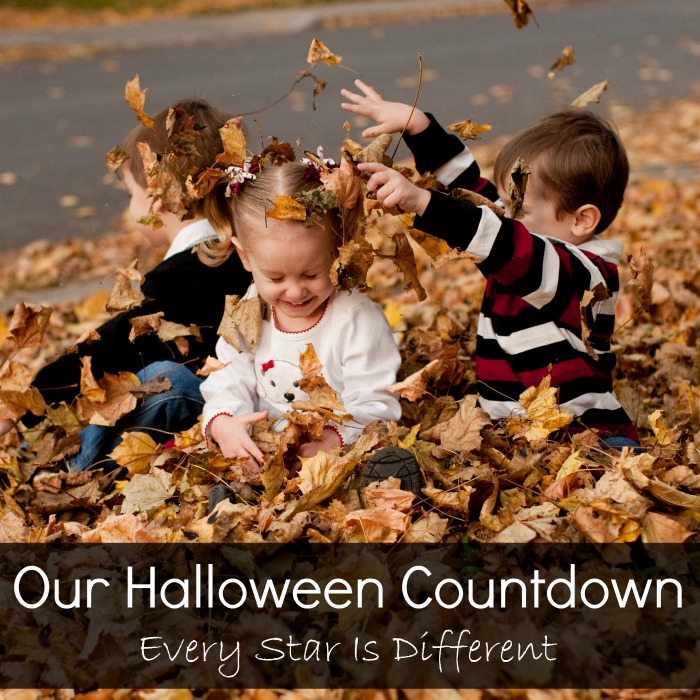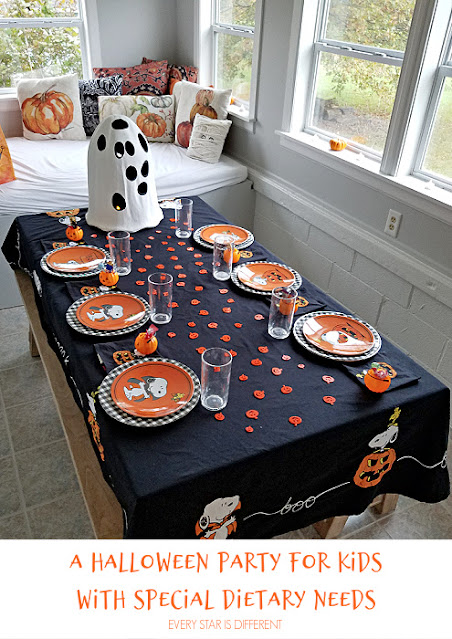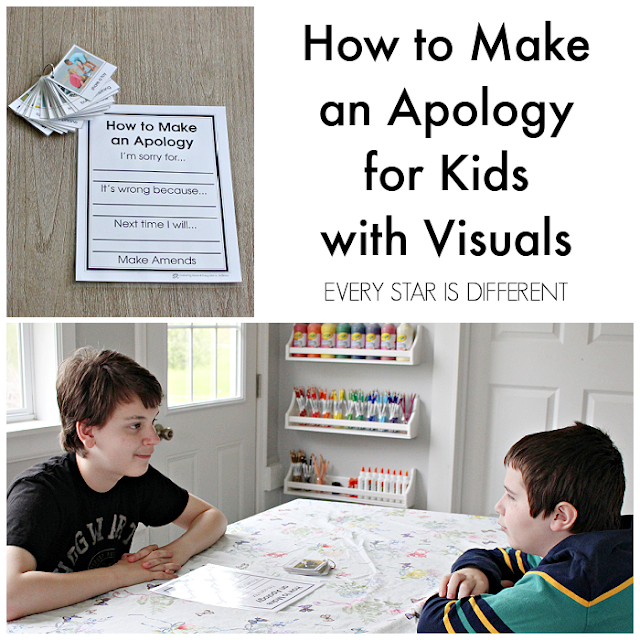What does it mean to make an apology?
How do you teach kids to be sincere when they apologize to peers and adults?
When working with children on on the autism spectrum, how do you help them with communicating an apology and deciding on an amends?
How do you teach empathy to a child with Reactive Attachment Disorder, especially one who continues to hurt others.
These are all very real struggles we've faced in our home. This post explains how we taught our kids to apologize.
We hope you enjoy these "How to Make an Apology" for kids tips and resources with visuals.
How to Make an Apology for Kids with Visuals
How to Teach Neurodiverse and Neurotypical Children to Make an Apology
There are four people in our family on the autism spectrum. Apologizing is often a challenging task, not because they don't want to apologize, but because they don't know what to say, or how to show they actually mean it.
Truthfully, many who aren't on the autism spectrum don't know how to make an apology appropriately, This is not a skill that only autistic people struggle to learn.
Due to situations in our home, that were occurring on a regular basis, I created a resource to help neurodiverse and neurotypical children learn the best way to make an apology.
The first part of the resource I created is a "How to Make an Apology" cheat sheet. This guides the kids through the apology process in four simple steps.
The second resource is our "Amends Cards." These are incredibly helpful when completing the last step of the apology process.
So how does one make a sincere and complete apology? Here are the four steps we've taught our children.
4 Steps to Make an Apology
1. I'm sorry for...
The kids use the phrase, 'I'm sorry for..." and then fill in the blank with whatever they have done.
It's incredibly important to make sure there is a conversation between the caregiver and the child who needs to apologize before the child is expected to carry out the apology.
The adult needs to ensure that the child knows what he did wrong, and that he are able to communicate this to the person he hurt.
In our home, sometimes this includes practicing what is going to be said.
2. It's wrong because...
After a child apologizes, it's incredibly important that he understands why the behavior was wrong and be able to communicate that to the person that's been hurt.
Again, this step is usually practiced with an adult before a child faces a sibling or other person.
3. Next time I will...
The third step of the apology requires the child to plan out what he will do next time instead of the behavior that hurt someone else.
Here's an example:
"Next time I will use a kind and quiet voice, instead of yelling at you, when I am feeling upset."
The child may not be perfect at following through with this step, but it's incredibly important to work on it and to understand that things can be done a different way.
Having a plan set up before hand to address a behavior is often the best way to avoid future incidents, especially if it's communicated out loud and caregivers can provide support in carrying it out.
4. Make amends.
The final step of an apology is "showing" that one is actually sorry. This means putting forth the effort to make an amends.
At times this can be the hardest step for multiple reasons.
Thinking of an amends can be difficult, especially for those on the autism spectrum who may not understand what that even means.
Carrying out an amends can cause frustration, especially when ideas are bigger and more time consuming than anticipated, interrupting rituals and routines.
For these reasons we have created cards that give kid-friendly choices of how to show love to others. These cards provide a variety of options to ensure that every child can be successful at making amends.
In our home, these are called the "Amends Cards." The kids know to grab them when they are required to make an apology, finding a task card that they're comfortable with, and one that the person their making amends to may enjoy.
Eventually they'll be able to come up with ideas for making amends on their own, but for now, these work fabulously well.
These cards take the anxiety out of making amends for kids on the autism spectrum which helps so much!
If you're wondering if this printable pack is worth it, be sure to check out our Physical Boundaries and Consent Activities for Kids. This post also includes resources and visuals from the same printable pack, explaining how we use them.
How to Teach Children with Reactive Attachment Disorder How to Make an Apology
For kids with Reactive Attachment Disorder or RAD, apologies are HARD. One characteristic of children with Reactive Attachment Disorder is a lack of empathy.
This lack of empathy is not their fault. They are not "bad" because of it. Their brains developed this way because of the trauma they endured.
Due to this challenge, empathy has to be learned and is often wrote and memorized for a VERY long time. This can change as healing occurs.
Apologies may sound insincere.
There WILL be battles over a requirement to apologize in many circumstances.
So how do we use the apology resources in the post with our children with Reactive Attachment Disorder?
We use them the same way, but know and understand the process will take a LOT longer and most likely will include battles.
The goal is to teach the skill to apologize successfully and consistently, despite battles and behaviors that may occur and despite the length of time it may take for the child to apologize.
In our home time stops until all steps of the apology are completed in a calm and kind manner.
The child attends to required tasks like school, chores, homework, meals, and hygiene tasks, but everything else is put on hold until the apology process is completed.
We've had to teach our other kids that the behaviors that occur after the apology is required, aren't about them, but about the child with Reactive Attachment Disorder not wanting to follow the caregiver's instructions.
We've had to teach our other kids that apologizing is REALLY HARD for kids with Reactive Attachment Disorder. It may take a LONG time for the apology to occur, but it will happen. The delay has nothing to do with them.
We've had to teach our other kids NOT to stop reporting behaviors because of all that occurs when an apology is required from the child with Reactive Attachment Disorder.
When someone in our home hurts another person in any way, a full apology is required. There are no exceptions.
The person who needs to apologize is in complete control of how long that process takes and chooses the behaviors that occur in the process.
The other thing we've taught our other children, is that it's okay not to forgive immediately.
It's okay to say thank you for the apology and look forward to seeing the person continuing to show she is sorry.
It's okay to set safe boundaries with a person who continues to hurt them. One can still love someone from a distance, and not put themselves in an abusive relationship.
So why go through all of this just for an apology with a child who has Reactive Attachment Disorder?
Apologies are a necessary part of life.
Every relationship we are a part of will at some point require an apology.
Apologies are one of the many social situations that all children must master in order to be successful adults in healthy relationships.
What parent doesn't want that?
Before I finish, I want to leave one more tip to help this process.
Practice through Role Play Situations
One thing we like to do when introducing a new social skill is to practice when no one has the need to use it.
As we practice new social skills in calm situations, the kids are much more likely to understand them and show mastery in them.
Bulldozer and Dinomite especially liked role playing the apology process, coming up with scenarios in which they had to apologize. You can tell this from the picture above. Their expressions crack me up as both were trying really hard not to break character and laugh.
Princess and Sunshine were able to demonstrate to all that they were able to apologize successfully without behaviors during the practice scenarios. This was incredibly important for siblings to see.
Once the role play was complete, the resources were put on the refrigerator for easy access and reminders.
We have used these apology resources and visuals for years. Dinomite, Bulldozer, and Princess have graduated from using them. Sunshine still needs them, but seems to enjoy using them.
Behaviors have improved with our kids with Reactive Attachment Disorder during the apology process.
All of this can be a lot of hard work for caregivers, but it's worth it!
For those who would like more resources for teaching social skills and emotional regulation, be sure to subscribe to our free newsletter by clicking the link below.
Don't forget to grab your apology resources today!
If you enjoyed this post, you may also enjoy the resources below.
















































